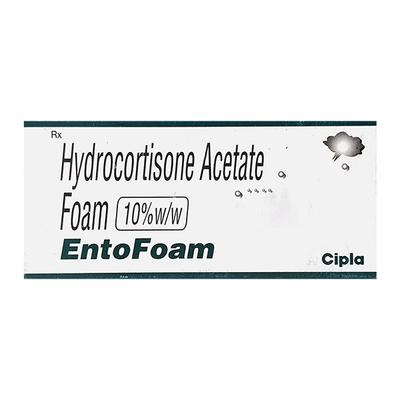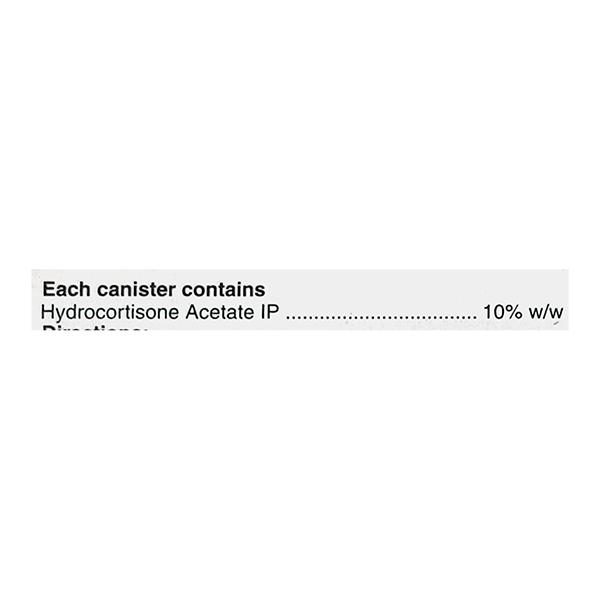

Netmeds First Membership
Quick Links
Introduction About ENTOFOAM 10% FOAM
ENTOFOAM 10% FOAM contains Hydrocortisone which belongs to the group of medicines called Corticosteroids. ENTOFOAM 10% FOAM is used in the topical management of inflammation of rectal mucosa that occurs due to conditions (such as ulcerative colitis, proctosigmoiditis, granular proctitis) in affected individuals.
ENTOFOAM 10% FOAM is not recommended for use in patients allergic to hydrocortisone. It is also not recommended for use in patients with anal warts (a type of sexually transmitted infection), and/or bacterial/fungal/viral infection. The medicine is also not indicated for use in patients suffering from obstruction, abscess, perforation, peritonitis, sinus tracts, and/or extensive fistulae and in patients who had undergone recently intestinal anastomosis/vaccination.
Before administering ENTOFOAM 10% FOAM, inform your doctor if you have severe ulcerative disease (chronic inflammation of colon and rectum), diabetes mellitus, myasthenia gravis (chronic autoimmune neuromuscular disease that weakness skeletal muscles), high blood pressure, severe affective disorders (such as depressive/manic depressive illness), heart problems (such as congestive heart failure, recent myocardial infarction), kidney problems (such as renal failure/insufficiency), and/or liver problems (such as chronic active liver disease, impaired hepatic function).
ENTOFOAM 10% FOAM should be used with caution in pregnant women only if it is clearly necessary. It is not recommended for use in breastfeeding women as the medicine may pass through milk. Consult your doctor before administering ENTOFOAM 10% FOAM.
ENTOFOAM 10% FOAM should be used with caution in children and adolescents (aged below 18 years) since long term use may cause potential reactions such as obesity, growth retardation. It is also used advised to be used with caution in elderly patients (aged above 65 years) after consulting the doctor.
Uses Of ENTOFOAM 10% FOAM
- Manage inflammation of rectal mucosa that occurs due to conditions (such as ulcerative colitis, proctosigmoiditis, granular proctitis) in affected individuals
How ENTOFOAM 10% FOAM Works
ENTOFOAM 10% FOAM works by inhibiting the accumulation of neutrophiles and macrophages (immune cells responsible for inflammation) and reduces the migration of leukocytes and mastocytes in the region of inflammation which results in reducing inflammation and providing relief from conditions such as ulcerative colitis, proctosigmoiditis, granular proctitis in affected individuals.
How to use ENTOFOAM 10% FOAM
Always use ENTOFOAM 10% FOAM as directed by your physician. It is for rectal use only. Shake well before use. Hold aerosol can upright and insert its nozzle into the tip of the applicator. Held it upright to obtain proper flow of medication. Fill the applicator by holding the barrel and gently pressing the aerosol can until the foam reaches the“fill line” in applicator body. Remove applicator from aerosol can and hold the applicator by its barrel. Gently, insert the tip into the anus and push the plunger to expel foam into the anus by standing with one leg raised/lying down on the side. Avoid inserting the nozzle can directly into the anus. Pull the applicator out after use and thoroughly clean it with warm water. Your doctor will decide the correct dose and duration for you depending upon your age, body weight and disease condition.
Side Effects Of ENTOFOAM 10% FOAM
Common
- burning sensation at the site of application
Rare
- central serous chorioretinopathy (eye disease that cause distort vision)
Stop administering ENTOFOAM 10% FOAM and contact your doctor immediately if you experience any of the following side effects:
- changes in eyesight
- irregular heartbeats
- fits
- signs of allergic reactions such as rash, itching, red itchy welts (on the skin), swelling of lips/face/lips/tongue, and/other parts of the body, shortness of breath, difficulty while breathing, and/or wheezing
- severe chest pains
- broken bones
Warning & Precautions
Pregnancy
ENTOFOAM 10% FOAM should be used with caution in pregnant women only if it is clearly necessary. Consult your doctor before administering the medicine.
Breastfeeding
ENTOFOAM 10% FOAM is not recommended for use in breastfeeding women as it may pass through milk. Consult your doctor before administering ENTOFOAM 10% FOAM.
Driving and Using Machines
ENTOFOAM 10% FOAM is unlikely to affect your ability to drive or operate machines.
Kidney
ENTOFOAM 10% FOAM should be used with caution in patients with kidney problems such as renal failure/insufficiency. Consult your doctor before using ENTOFOAM 10% FOAM.
Liver
ENTOFOAM 10% FOAM should be used with caution in patients with liver problems such as chronic active liver disease, impaired hepatic function. Consult your doctor before using the medicine.
Allergy
Do not use ENTOFOAM 10% FOAM if you are allergic to hydrocortisone, and/or any other ingredients of this medicine.
Heart Disease
ENTOFOAM 10% FOAM should be used with caution in patients with heart disease such as congestive heart failure, recent myocardial infarction. Consult your doctor before using ENTOFOAM 10% FOAM.
Others
ENTOFOAM 10% FOAM is not recommended for use if you:
- have anal warts
- have fungal, viral, tuberculous, and/or bacterial infections
- suffer from obstruction, abscess, perforation, peritonitis, sinus tracts, extensive fistulae
- had recent intestinal anastomosis
- have recently been vaccinated
- have narrow/wide angle glaucoma
Before using ENTOFOAM 10% FOAM, inform your doctor if you:
- suffer from severe ulcerative disease (chronic inflammation of colon and rectum)
- have diabetes mellitus
- suffer from myasthenia gravis (chronic autoimmune neuromuscular disease that weakness skeletal muscles)
- high blood pressure
- have/had severe affective disorders such as depressive/manic depressive illness
- are scheduled for vaccination
- suffer from trauma/infection (associated with fever)
- are a post-menopausal woman
- suffer from latent tuberculosis
- suffer from thyroid problems
- have active/laten peptic ulcer, diverticulitis, and nonspecific ulcerative colitis
Use in Paediatrics:
ENTOFOAM 10% FOAM should be used with caution in children and adolescents (aged below 18 years) since long term use may cause potential reactions such as obesity, growth retardation, osteoporosis (condition marked by weak & brittle bones), and adrenal suppression (adrenal gland insufficiency). Consult your doctor before using the medicine.
Use in Geriatrics:
ENTOFOAM 10% FOAM should be used with caution in elderly patients (aged above 65 years). Consult your doctor before using ENTOFOAM 10% FOAM.
Interactions
A. Drug-Drug interactions:
Before using ENTOFOAM 10% FOAM, inform your doctor if you are taking any of the following medicine:
- cardiac glycoside (used to manage heart failure and certain irregular heartbeats) Ex. acetyldigitoxin, deslanoside
- medicines used to manage high blood pressure such as diuretics (Ex. chlorothiazide, chlorthalidone)
- amphotericin B (used to manage serious fungal infections)
- macrolide antibiotics (medicines used to manage various bacterial infections) Ex. azithromycin, clarithromycin
- antidiabetics (medicines used to manage diabetes) Ex. insulin, metformin
- NSAIDs (medicines used to reduce inflammation and provide relief from pain) Ex. ibuprofen, aspirin
- medicine used in HIV (Ex. ritonavir)
- antiretroviral agents (medicines used to manage HIV) Ex. abacavir, didanosine
- medicine used for blood thinning (Ex. warfarin)
- phenytoin, phenobarbital (medicines used to manage seizure)
- ephedrine (used to manage low blood pressure under anaesthesia, allergic conditions, bronchial asthma)
- rifampicin (used to manage tuberculosis)
- ketoconazole (medicine used to manage fungal infections)
Overdosage:
If you or anyone else accidentally administers too much of ENTOFOAM 10% FOAM, consult your doctor immediately or visit the nearby hospital. Symptoms of overdose are increased sodium and water retention, increased appetite, mobilisation of calcium and phosphorus with osteoporosis, nitrogen depletion, high blood sugar, altered effects on tissue repair, increased susceptibility to infection, adrenal insufficiency, adrenal cortex hyperactivity, mental & neurological disturbances, and/or muscular weakness.
Synopsis
| Drug | : | Hydrocortisone |
| Pharmacological Category | : | Corticosteroids |
| Therapeutic Indication | : | Inflammation of rectal mucosa (due to conditions such as ulcerative colitis, proctosigmoiditis, granular proctitis) |
| Dosage Forms | : | Cream, Foam, Enema, Tablet, Injection |
More Information
- Keep ENTOFOAM 10% FOAM out of reach of children
- Store ENTOFOAM 10% FOAM below 25°C
FAQs About ENTOFOAM 10% FOAM
What is ENTOFOAM 10% FOAM used for?
ENTOFOAM 10% FOAM is used in the topical management of inflammation of rectal mucosa that occurs due to conditions (such as ulcerative colitis, proctosigmoiditis, granular proctitis) in affected individuals.
How ENTOFOAM 10% FOAM works?
ENTOFOAM 10% FOAM works by inhibiting the accumulation of neutrophiles and macrophages (immune cells responsible for inflammation) and reduces the migration of leukocytes and mastocytes in the region of inflammation which results in reducing inflammation and providing relief from conditions such as ulcerative colitis, proctosigmoiditis, granular proctitis in affected individuals.
How ENTOFOAM 10% FOAM should be administered?
Always use ENTOFOAM 10% FOAM as directed by your physician. It is for rectal use only. Shake well before use. Hold aerosol can upright and insert its nozzle into the tip of the applicator. Held it upright to obtain proper flow of medication. Fill the applicator by holding the barrel and gently pressing the aerosol can until the foam reaches the “fill line” in applicator body. Remove applicator from aerosol can and hold the applicator by its barrel. Gently, insert the tip into the anus and push the plunger to expel foam into the anus by standing with one leg raised/lying down on the side. Avoid inserting the nozzle can directly into the anus. Pull the applicator out after use and thoroughly clean it with warm water. Your doctor will decide the correct dose and duration for you depending upon your age, body weight and disease condition.
Can ENTOFOAM 10% FOAM be used in pregnant and breastfeeding women?
ENTOFOAM 10% FOAM is advised to be used in pregnant women with caution only if it is clearly necessary. It is generally not recommended for use in breastfeeding women since it passes through breast milk. Consult your doctor before using ENTOFOAM 10% FOAM.
What happens if ENTOFOAM 10% FOAM is taken more than the required dosage?
If you or anyone else accidentally administers too much of ENTOFOAM 10% FOAM, consult your doctor immediately or visit the nearby hospital. Symptoms of overdose are increased sodium and water retention, increased appetite, mobilisation of calcium and phosphorus with osteoporosis, nitrogen depletion, high blood sugar, altered effects on tissue repair, increased susceptibility to infection, adrenal insufficiency, adrenal cortex hyperactivity, mental & neurological disturbances, and/or muscular weakness.
References
1. KD Tripathi. Drugs Acting on Skin and Mucous Membranes. Essentials of medical pharmacology. Seventh edition. 2013 Page: 895.
2. Jonathan Blackwell, Christian Selinger, Tim Raine, Gareth Parkes, Melissa A Smith, Richard Pollok. Steroid use and misuse: a key performance indicator in the management of IBD. NIH National Library of Medicine. National Center for Biotechnology Information. PMC PubMed Central. April 2020. [Accessed on 8th August 2022] https://www.ncbi.nlm.nih.gov/pmc/articles/PMC8040510/
3. Sarah Gabros; Trevor A. Nessel; Patrick M. Zito. Topical Corticosteroids. NIH National Library of Medicine. National Center for Biotechnology Information. StatPearls [Internet]. August 2022. [Accessed on 8th August 2022] https://www.ncbi.nlm.nih.gov/books/NBK532940/
4. Viatris Ltd. New Zealand Medicines and Medical Devices Safety Authority (MEDSAFE). [Revised in December 2021] [Accessed on 8th August 2022] https://www.medsafe.govt.nz/profs/datasheet/c/colifoamfoam.pdf
5. Cipla Ltd. ENTOFOAM Rectal Foam. [Revised in April 2021] [Accessed on 8th August 2022] https://www.ciplamed.com/content/entofoam-rectal-foam
Useful Diagnostic Tests
- Colonoscopy
- Sigmoidoscopy










